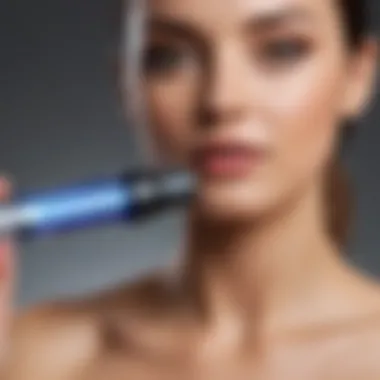Top At-Home Hair Removal Methods Explained


Intro
At-home hair removal offers a unique blend of convenience and cost-effectiveness. With numerous options available, women can choose methods that align with their preferences and needs. This guide delves into the most popular at-home hair removal techniques, discussing the advantages, disadvantages, and essential tips for optimal skin care.
Understanding these methods helps in recognizing what works best for individual skin types and hair growth patterns. In this article, we explore traditional techniques like shaving and waxing, alongside modern innovations such as laser treatments. By providing a balanced overview, we aim to equip readers with the information necessary for informed decisions regarding their hair removal practices.
Preamble
Hair removal is a subject that resonates with many women, making it an essential topic for discussion. The methods available for removing unwanted hair have evolved immensely over time, ranging from traditional techniques to modern innovations. With a plethora of options at one's disposal, it is vital to understand the various methods and their implications on skin health and aesthetics.
The advent of new technology has not diminished the significance of traditional practices. Factors like efficiency, cost-effectiveness, and convenience remain paramount considerations. For example, while some may prefer the quick results of shaving, others may opt for longer-lasting effects provided by waxing or laser treatments.
Moreover, different skin types and sensitivities necessitate individualized approaches to hair removal. It is critical to evaluate each method on the basis of skin compatibility and effectiveness. Understanding the science behind hair growth and cultural attitudes towards hair removal can also enhance one’s perspective on this everyday practice.
In this guide, readers will discover a variety of at-home hair removal methods. Each method will be analyzed in terms of its unique advantages and any potential drawbacks. The ultimate aim is to equip individuals with the knowledge needed to make informed choices regarding their hair removal routines, ensuring both aesthetic outcomes and skin health.
Understanding Hair Removal
The process of hair removal is not just a matter of personal preference; it is influenced by several factors, including culture, biology, and individual comfort. Understanding hair removal can empower individuals to make informed choices that align with their needs and values. This section will delve into key elements surrounding hair removal, emphasizing its significance and complexity.
The Science of Hair Growth
Hair growth is a biological process influenced by various factors such as genetics, hormones, and age. Each hair follicle operates independently, undergoing cycles of growth, rest, and shedding. The growth phase, known as the anagen phase, can last several years for some people, while the telogen phase, where hair rests and eventually falls out, may last for a few months. For those seeking to remove hair, recognizing the stage of hair growth is crucial.
In simple terms, hair grows from the follicle embedded in the skin. Each hair is made predominantly of a protein called keratin. Understanding this biology helps in selecting the appropriate removal method, as certain techniques work better on hairs at different points in their growth cycles.
Furthermore, hair thickness and color also play a critical role in how effective various removal methods will be. Dark, coarse hair tends to respond better to laser treatments, while finer hair may not be as easily managed with waxing or shaving. The distinction between vellus hair and terminal hair is also important. Vellus hair is fine and lightly pigmented, while terminal hair is thicker and darker. This knowledge can aid in choosing methods that will deliver the best results each time.
Cultural Perspectives on Hair Removal
Cultural attitudes regarding hair removal vary significantly across the globe. In some cultures, hair removal is a daily routine and a symbol of cleanliness and beauty. Conversely, other societies celebrate body hair as a natural part of human form. This divergence affects women's choices in hair removal, shaping their routines according to their cultural context.
For instance, in many Western societies, smooth skin is often viewed as attractive, leading to widespread practices like shaving, waxing, and laser treatments. These methods are advertised and marketed aggressively, emphasizing the notion that hairless skin is synonymous with beauty. Conversely, many cultures in the Middle East or parts of Asia may embrace different norms, often passing down traditional methods of hair removal such as threading or sugaring, which have been utilized for generations.
Understanding these cultural perspectives can help women navigate their own choices. One must consider their values and the societal pressures which may influence their preferences. Hair removal should ultimately reflect personal choice, not merely adhere to external expectations.
Traditional Methods of Hair Removal
Traditional methods of hair removal have served as the foundation for personal grooming practices for centuries. Their importance lies in the variety of techniques available to cater to different hair types, pain thresholds, and skin sensitivities. Women often prefer these methods due to their accessibility, cost-effectiveness, and straightforward application processes. Understanding traditional methods provides insights into time-tested practices that can help achieve desired hair-free skin. Despite advances in technology, traditional methods still hold a significant place in the realm of at-home hair removal.
Shaving
Tools Required
Shaving is one of the most common at-home hair removal methods. The tools required for this process include a quality razor, shaving cream or gel, and an after-shave lotion for skin protection. A good razor is essential because it ensures a close shave and minimizes the risk of nicks and cuts. Shaving creams help to soften the hair and protect the skin. Some people choose disposable razors for convenience, while others prefer safety razors for a closer and more eco-friendly option. The unique aspect of shaving is its immediate result, offering quick hair removal with little prep time. However, it might lead to skin irritation or razor burn if not done correctly.
Best Practices
When it comes to shaving, best practices can greatly enhance the experience and results. Always shave in the direction of hair growth to prevent irritation and ingrown hairs. Exfoliation before shaving is recommended to remove dead skin cells and allow for a smoother shave. Using a sharp blade is key to reducing tugging and discomfort. Aftershave products containing soothing ingredients like aloe vera or chamomile can be beneficial in calming the skin post-shave. An important consideration is the frequency of shaving, as daily shaving may lead to irritation, while less frequent shaving can result in longer hair and a more challenging shave.
Pros and Cons
The pros of shaving include its simplicity, speed, and low cost compared to other methods. It is generally painless when done correctly. However, the cons include a temporary solution, requiring frequent upkeep, and the potential for skin irritation and ingrown hairs. Users may find that shaving offers quick results, but it does not provide the longevity found in methods like waxing or sugaring. This balance of advantages and disadvantages makes shaving a reliable yet maintenance-heavy choice for hair removal.
Waxing


Types of Wax
Waxing provides a more durable hair removal method compared to shaving. Various types of wax are available, including hard wax and soft wax. Hard wax typically adheres to hair rather than skin and is removed without the use of cloth strips, making it ideal for sensitive areas. Soft wax, on the other hand, requires strips and is best for larger areas. The key characteristic of waxing is its effectiveness in pulling hair from the root, offering results that can last for weeks. However, the process can be painful, especially for beginners.
Application Techniques
Proper application is crucial for effective waxing. To start, ensure the skin is clean and dry, as this allows for better adhesion of the wax. The wax should be applied in the direction of hair growth and removed against it. The application needs to be at an appropriate temperature to avoid skin burns. Technique is vital; for beginners, using a kit with instructions can ease the learning process. Knowing how to apply and remove wax accurately affects the experience significantly, as improper technique can lead to suboptimal results.
Post-Wax Care
Post-wax care is essential to soothe the skin after the procedure. It involves avoiding hot baths, intense workouts, and strong skin products for at least 24 hours. Applying an aloe vera gel or a calming lotion can help reduce irritation and redness. The key feature of post-wax care is that it directly impacts the skin’s recovery, preventing bumps and potential infections. Neglecting this step may lead to discomfort and unsightly skin reactions.
Sugaring
Ingredients Needed
Sugaring, another natural method of hair removal, requires few simple ingredients: sugar, lemon juice, and water. The natural ingredients make it an appealing choice for those who prefer chemical-free solutions. This method is effective for removing hair from the root, similar to waxing, with less discomfort for many individuals. The formula can be adjusted for different consistencies, and this aspect contributes to its popularity. Moreover, the homemade nature of sugaring appeals to the growing interest in DIY beauty solutions.
How to Apply
Applying sugaring paste involves a similar technique to waxing. The mixture should be applied against hair growth with a finger or tool and removed in the opposite direction. The key here is to ensure that the paste is at the right temperature and consistency. Practice can improve application efficiency, making sugaring a viable option for those seeking a less painful hair removal experience. The straightforward process and natural ingredients promote its appeal to a wide audience.
Comparison to Waxing
When comparing sugaring to waxing, a few differences are noteworthy. Sugaring tends to be less painful as it adheres mainly to hair rather than skin. Also, it can be more easily cleaned up with water, while wax might require oil for complete removal. However, sugaring may not provide as much grip on coarse hair, which can lead to a less effective removal process than certain wax types. Understanding these differences enables individuals to choose a method best suited to their needs.
Modern Techniques for Hair Removal
Modern techniques for hair removal represent significant advancements in personal care, reflecting both innovation in technology and changing preferences of consumers. These methods are distinct because they provide more precise, effective, and longer-lasting results compared to traditional methods. Many individuals seek these options for their convenience and time efficiency, as they often minimize the frequency of hair removal sessions.
Additionally, they cater to different skin types and hair textures, allowing for a more personalized approach. Understanding modern techniques is essential for making informed choices that align with one's lifestyle and skin health.
Laser Hair Removal Devices
How They Work
Laser hair removal devices employ concentrated beams of light to target hair follicles. The light is absorbed by the pigment in the hair, which damages the follicles and inhibits future hair growth. This method can be very effective for individuals with dark hair and lighter skin. A key characteristic of this technique is its precision, allowing it to focus on specific areas without affecting surrounding skin.
However, effectiveness can vary depending on hair color and skin tone. For example, lighter hair colors may not absorb the light as efficiently, which could lead to less effective treatment outcomes.
Benefits and Risks
The benefits of laser hair removal include long-term reduction of hair growth. Many users experience significant reduction after several sessions, leading to less frequent hair removal routines. Additionally, the process is relatively quick, especially for larger areas. However, risks can include skin irritation, burns, or changes in skin pigmentation. It is essential for users to fully understand these risks prior to committing to this method.
Choosing the Right Device
Selecting the right laser hair removal device involves considering several factors. Users should assess their skin type and hair color, as some devices are better suited for specific combinations. A key characteristic in choosing is the device's wavelength and pulse duration. These attributes determine how effectively the device can target hair follicles without damaging surrounding tissue. Some users may prefer professional treatments, while others may opt for at-home devices, which generally offer convenience but may require additional care and understanding of usage guidelines.
Electric Epilators
Types of Epilators
Electric epilators vary widely in design and function. Some are designed for specific body parts, while others are multifunctional. The main types include spring-based epilators, which use a coiled spring to remove hair, and disc-based models, which use multiple rotating discs. Each type has specific benefits. For instance, disc-based epilators may provide a closer hair removal experience but can cause more discomfort.
Usage Tips


To maximize results while using an epilator, it is advisable to exfoliate before the process. This helps to prevent ingrown hairs and improves the effectiveness of the epilation. Additionally, using the device at a low speed initially can aid in comfort as individuals adjust to the sensation. Proper technique can minimize pain and enhance the overall effectiveness of hair removal.
Maintenance
Regular maintenance of epilators is crucial for longevity and performance. Cleaning the head after each use removes hair and prevents build-up, which can affect efficacy. Users should check for any worn parts and replace them as needed to ensure continued quality in hair removal. Some models offer washable heads, making cleaning more straightforward, which can be a significant advantage.
Depilatory Creams
How They Function
Depilatory creams work by breaking down the protein structure of the hair, causing it to dissolve and making it easy to wipe away. This process is largely chemical, relying on active ingredients that interact with keratin in the hair. A primary advantage of this method is its ease of use; the application is generally straightforward, allowing for quick hair removal.
However, users need to be cautious as these creams can cause allergic reactions in sensitive individuals. It is always recommended to conduct a patch test before full application to ensure skin compatibility.
Skin Sensitivity Considerations
When using depilatory creams, skin sensitivity plays a critical role. Some individuals may experience irritation or allergic reactions, particularly with prolonged use. Ingredients in these creams vary significantly, and awareness of one's skin type is essential in selecting the right product. Those with sensitive skin should seek creams specifically formulated for gentler application, as these products are less likely to cause discomfort.
Product Recommendations
In selecting depilatory creams, reading reviews and verifying the product's efficacy for different skin types is beneficial. Many brands claim to be gentle and suitable for sensitive skin, but results can differ. Keeping an eye on well-reviewed and trusted brands can reduce the risk of adverse reactions and enhance satisfaction with the hair removal process.
Natural and Alternative Hair Removal Solutions
Natural and alternative hair removal solutions hold significant appeal for those seeking effective methods without the harsh chemicals often found in commercial products. These methods offer a gentler approach, making them especially desirable for individuals with sensitive skin or those who prioritize using eco-friendly and cost-effective options. Additionally, natural solutions frequently incorporate ingredients that provide added skin benefits, enhancing overall skin health while effectively removing unwanted hair.
Home Remedies
Turmeric Paste
Turmeric paste has gained popularity as a natural hair removal remedy due to its anti-inflammatory and antibacterial properties. The active ingredient, curcumin, is known for its ability to inhibit hair follicle growth, making it a valuable tool in the quest for smooth skin. To prepare, mix turmeric powder with water or milk to form a thick paste. Apply it to the desired area, let it dry, and then gently scrub it off using warm water.
Key Characteristics:
Turmeric is recognized for its bright yellow hue and strong fragrance. This natural remedy is beneficial because it doesn't just target hair removal; it also promotes skin healing.
Advantages and Disadvantages:
While turmeric paste is effective for many, it can cause skin staining, especially on lighter skin tones. Using it frequently can lead to noticeable discoloration, which is an important consideration for users.
Essential Oils
Essential oils, such as lavender and tea tree, can also be utilized in hair removal strategies. Their antifungal and antiseptic properties not only help minimize irritation but also nourish the skin post-hair removal. Adding a few drops of these oils to a carrier oil creates a soothing mixture that can help with hair removal and skin care.
Key Characteristics:
Essential oils are concentrated plant extracts, admired for their therapeutic benefits. They provide a sensory experience, adding aromatherapeutic value while promoting skin clarity.
Advantages and Disadvantages:
These oils are generally safe, but some can lead to allergic reactions or sensitivity in some individuals. Therefore, conducting a patch test before widespread use is crucial.
Almond Oil and Sugar Scrubs
Almond oil mixed with sugar serves as an effective exfoliant, helping to remove dead skin cells while also addressing unwanted hair. The granules of sugar provide the necessary abrasiveness, while almond oil hydrates and softens the skin. When massaged into the skin, it can assist in loosening hair follicles gradually.
Key Characteristics:
This combination is particularly well-liked for its moisturizing effects. Almond oil is rich in vitamin E, benefiting the skin’s texture and health.
Advantages and Disadvantages:
While this remedy is effective, it may require repeated applications over time to see significant results. Additionally, those with nut allergies should avoid almond oil to prevent adverse reactions.
Traditional Remedies from Various Cultures
Indian Practices


Indian practices encompass a wide range of natural methods for hair removal, often derived from ancient traditions. Ingredients such as gram flour, rose water, and coconut oil dominate these remedies. Gram flour acts as a gentle exfoliant while hindering hair regrowth.
Key Characteristics:
The focus is on natural, accessible ingredients that can often be found in every household, promoting not just hair removal but also general skin health.
Advantages and Disadvantages:
These methods are often time-consuming and results may vary between individuals. However, they are generally safe and nourishing for the skin.
Middle Eastern Traditions
Middle Eastern hair removal traditions, such as the use of sugar or honey-based waxing, have stood the test of time. This method, often referred to as "sugaring," involves a simple blend of sugar, lemon juice, and water, heated to create a sticky paste that adheres to the hair and pulls it from the root.
Key Characteristics:
This technique is celebrated for its natural ingredients and is often less painful than traditional waxing, providing a gentler alternative for hair removal.
Advantages and Disadvantages:
Although effective, it can be a bit messy to prepare and requires practice to master the technique for optimal results.
Adopting natural and alternative hair removal solutions can lead to healthier skin and more sustainable choices without compromising efficacy.
Best Practices for Skin Care After Hair Removal
Skin care after hair removal is important for maintaining the health and appearance of the skin. After such procedures, the skin can be sensitive and may react in various ways. Good post-removal care can enhance results and minimize discomfort. Being proactive about skin care helps in ensuring that the skin remains healthy and smooth. This section provides an overview of essential practices that should be considered after hair removal to achieve optimal skin recovery and radiance.
Avoiding Irritation
Irritation is a common concern following hair removal. The procedure can strip away dead skin cells, leaving the fresh skin exposed and vulnerable. To prevent irritation, it is advisable to avoid hot showers or baths immediately after. Instead, lukewarm water can be soothing. Additionally, wear loose-fitting clothing to reduce friction against freshly treated skin.
Key points to consider include:
- Use Gentle Products: Opt for fragrance-free and alcohol-free cleansers to minimize skin reactions.
- Limit Sun Exposure: The skin is more sensitive post-removal. Applying a sunscreen with SPF 30 or higher is crucial when exposing skin to sunlight.
- Avoid Scrubs: Exfoliating scrubs should be avoided for at least 48 hours. This will help prevent micro-tears in the skin.
Moisturizing Techniques
Keeping the skin adequately moisturized can significantly enhance comfort and recovery. Moisturizers provide hydration which is essential in improving skin elasticity and soothing irritation. Using appropriate products helps to build a protective barrier over the skin.
Some ideal moisturizers include:
- Aloe Vera Gel: Known for its soothing properties, aloe vera can help calm irritation.
- Shea Butter: It is highly nourishing and can provide deep hydration.
- Natural Oils: Oils like coconut or almond oil can be effective in providing moisture without synthetic additives.
Applying a moisturizer immediately after hair removal, when the skin is still slightly damp, can help lock in moisture. Further, reapplying every few hours can be beneficial, especially in dry climates.
Long-Term Skin Health
Beyond the immediate recovery phase, long-term skin health should also be targeted. Regular skin care routines can prevent future issues like ingrown hairs and uneven skin tone. Incorporating practices that keep the skin balanced is vital.
Consider the following strategies:
- Regular Exfoliation: Gentle exfoliation once or twice a week can significantly aid in preventing ingrown hairs. Choose soft scrub options to avoid further irritation.
- Hydration: Consuming sufficient water daily supports easy skin management from the inside out.
- Healthy Diet: Include vitamins and minerals that nourish the skin, such as Vitamin E and antioxidants.
"Maintaining skin health is a journey, not a destination. Consistency is key to keeping skin looking its best."
Finale
In this comprehensive guide on at-home hair removal methods, we explore the diverse options available to women, emphasizing the significance of making informed choices tailored to personal preferences and skin types. As individuals pursue various hair removal solutions, understanding not just the methods but also their implications on skin health becomes paramount.
The discussion of traditional methods such as shaving, waxing, and sugaring ensures that readers are aware of time-tested approaches, each with its unique benefits and drawbacks. The insights into modern techniques like laser hair removal devices and electric epilators highlight the advancement of technology in personal grooming, making it easier and more effective than ever before. Moreover, natural solutions prove to be significant alternatives for those who prefer holistic care.
It is essential to recognize that skin care after hair removal plays a crucial role in maintaining skin health. Post-hair removal care, including moisturizing and avoiding irritation, is as significant as the method chosen. Neglecting skin health can negate the benefits of any hair removal technique, making education on aftercare practices equally vital.
Ultimately, the aim of this guide is to empower women by providing the necessary knowledge to choose the most suitable hair removal methods tailored to their lifestyles and skin requirements. This understanding not only promotes efficiency and cost-effectiveness but also elevates confidence in personal grooming routines.
"Informed choices lead to better outcomes - this applies to all facets of life, including self-care and grooming."
By synthesizing the information presented throughout the article, readers are equipped to navigate the often-overwhelming landscape of hair removal options. They can identify methods that enhance their grooming experience while ensuring their skin remains healthy and radiant.







